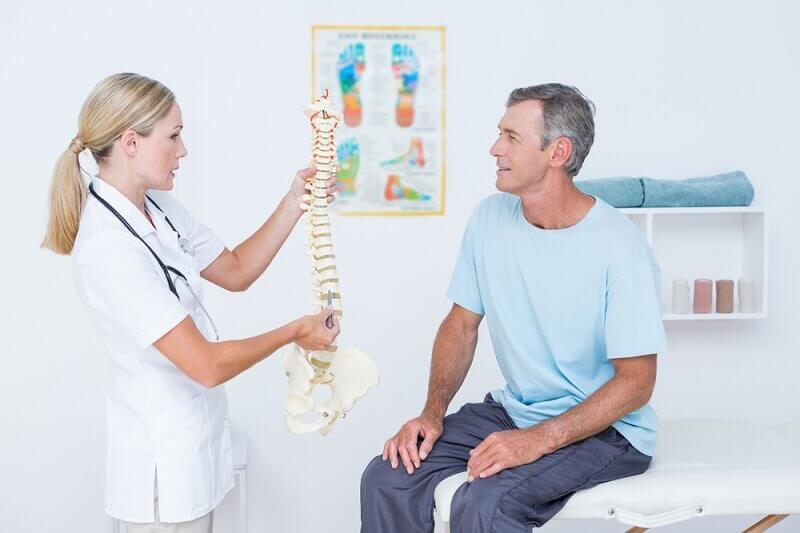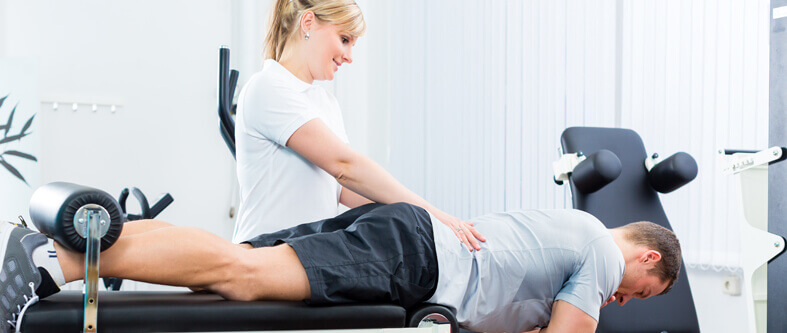See details
READ MORE
Experience has shown us that, in many cases, the herniated disc heals better when we do not use a scalpel, but follow a series of physiokinetotherapy procedures recommended by the specialist. Also, if you have had surgery, physical therapy can prevent a recurrence.
Centrokinetic offers complete services in the treatment of hernia, from the moment of diagnosis - surgical or non-surgical treatment procedure - to the complete recovery mix: physiotherapy, physical therapy, vertebral elongations, manual therapy, specific procedures.
What is a herniated disc?
To talk about a herniated disc as a neurological condition, we must first understand how the spine works and what it is made of. The spine consists of a series of bones called vertebrae, connected by an intervertebral disc, which in turn consists of a resistant, fibrous membrane on the outside, and a soft and elastic central area inside, in the center of the disk.
This intervertebral disc, if healthy, works as a shock absorber that, in addition to keeping the spine straight, healthy, in a correct posture, also protects it from possible shocks caused by running fast or lifting weights. When the discs deteriorate as a result of aging or injury, the fibrous membrane ruptures, the overall pressure on the central area increases, and thus the disc herniation occurs.

Causes of disc herniation:
Specialists believe that a herniated disc has an important genetic component, especially in patients with lumbar herniation, but most of the risk factors that favor the appearance of a herniated disc are closely related to the fast-forward lifestyle we all know we have:
- predisposition to sedentarism
- smoking
- Exaggerated physical exertion after long rest
- lifting weights wrong
- office work: 80% of those who stay in the office for 9-10 hours have discopathy or lower back pain
How to effectively treat a herniated disc:
If you have been diagnosed with a herniated disc and still the symptoms are not unbearable, do not neglect the treatment just because you feel good at the moment. Its postponement leads to complications, culminating in chronic pain, impaired mobility, or permanent injuries.
The goals of disc herniation treatment are to relieve pain and stop the progression of the condition. Centrokinetic has one of the best performing departments for treating spinal disorders, our medical team offering ultra-performing treatments.
Surgery
The operation consists of the surgical removal of the fragments of the disc or even of the entire herniated disc that presses on the nerve roots.
The biggest problem with herniated disc surgery is recurrence. Over time, the lack of the intervertebral disc can cause new pain, because the space between the vertebrae remains free and the other discs can move. In most cases, this evolution of the problem comes with the recommendation to perform a new operation.
In the long run, it has been shown that very good results are obtained for the patient and through a personalized recovery program, through physiokinetotherapy. Instead of removing the herniated disc, this method consists of exercises that gradually push the disc into its original position. To return to pre-diagnosis health, the patient must follow complex physiotherapy and physical therapy programs, under the guidance of an overspecialized medical team.
We must understand that there are large hernias that have an absolute surgical indication and hernias that can be treated non-surgically. This decision depends on the patient's symptoms and the imaging (MRI) of the lesion.
Physical therapy
In a herniated disc, one of the main therapeutic goals to consider is to lower the pressure in the herniated disc, along with decreasing the pressure on the roots of the sciatic nerve. Physical therapy includes exercises to tone the back muscles, to obtain a correct position of the spine, but also to relieve pain and stabilize the spine in the long term, effectively treating the condition.

Physiotherapy
Physiotherapeutic treatment in disc herniation is beneficial in relieving pain and involves electrotherapy, hydrotherapy, balneotherapy. The main effects of this form of treatment are anti-inflammatory, decontracting (with muscle relaxation effect), and hyperemic (increasing local blood flow).
Because there are many forms of electrotherapy in the treatment of disc herniation - interference currents, galvanic current, etc., the treatment can be shortened by combining procedures.
Massage, adjuvant treatment in disc herniation
The massage relaxes the muscles and stimulates the secretion of intraarticular synovial fluid - through which the soft structures inside the joints are fed, including the intravertebral disc - being beneficial in muscle contractions. Thus, it calms the pain and improves the local blood flow. Massage is a very popular procedure for patients with a herniated disc due to its strong and fast analgesic effect.
Elongations in the herniated disc
In disc herniation, elongations are extremely effective and not at all invasive. It is a three-dimensional decompression of the vertebrae. Your vertebrae will be repositioned correctly by technological traction executed in perfect parameters.

Following this procedure, the intervertebral discs are unlocked, which favors the healing environment. Everything takes place safely and without any pain. Accompanied by physiotherapy, the effects are felt right after the first session: reduction of the intensity of pain and inflammation, relaxation of the muscles, and even an increase in height of one or two centimeters.
Kinesiotaping in disc herniation
It is an adhesive bandaging technique, with the role of speeding up the healing process. The kinesiological tape is made of cotton and has acrylic adhesive. Its elasticity is often similar to that of human skin. The properties of the adhesive are activated by body heat, and the tape is water-resistant, being able to be worn even for several days and thus accelerating the recovery process.

Prices
You can find here a detailed list of the prices of individual services. But any correct recovery process is based on a mixed plan of therapies and procedures, customized according to the condition, stage of the condition, patient profile, and other objective medical factors. As a result, in order to configure a treatment plan, with the therapies involved and the prices related to the plan, please make an appointment here for an initial consultation.
About Centrokinetic
Centrokinetic clinic offers all services necessary for a complete rehabilitation process, from the first consultation to the medical specialist to establish the correct diagnosis, to treatment and recovery.
Centrokinetic is the place where you will find clear answers and solutions for your motricity problems. The clinic is dedicated to osteoarticular conditions and is divided into the following departments:
- Orthopedics, a department composed of an extremely experienced team of orthopedic doctors, led by Dr. Andrei Ioan Bogdan, primary care physician in orthopedics-traumatology, with surgical activity at Medlife Orthopedic Hospital, specialized in sports traumatology and ankle and foot surgery.
- Pediatric orthopedics, where children's sports conditions are treated (ligament and meniscus injuries), spinal deformities (scoliosis, kyphosis, hyperlordosis) and those of the feet (hallux valgus, hallux rigidus, equine larynx, flat valgus, hollow foot).
- Neurology, which has an ultra-performing department, where consultations, electroencephalograms (EEG) and electromyography (EMG) are performed.
- Medical recovery for adults and children, department specialized in the recovery of performance athletes, in spinal disorders, in the recovery of children with neurological and traumatic diseases. Our experience is extremely rich, treating over 5000 performance athletes.
- Medical imaging, the clinic being equipped with ultrasound and MRI, high-performance devices dedicated to musculoskeletal disorders, and complemented by an experienced team of radiologists: Dr. Sorin Ghiea and Dr. Cosmin Pantu, specialized in musculoskeletal imaging.
Find the latest news by following the Facebook, Instagram and YouTube accounts of the Centrokinetic clinic.
SUCCESSFUL RECOVERY STORIES
MAKE AN APPOINTMENT
FOR AN EXAMINATION
See here how you can make an appointment and the location of our clinics.
MAKE AN APPOINTMENT




































































































































